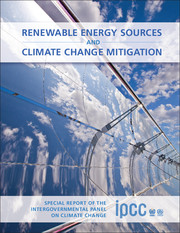 Renewable Energy Sources and Climate Change Mitigation
Renewable Energy Sources and Climate Change Mitigation Book contents
- Frontmatter
- Contents
- Section I
- Section II
- Section III
- Chapter 1 Renewable Energy and Climate Change
- Chapter 2 Bioenergy
- Chapter 3 Direct Solar Energy
- Chapter 4 Geothermal Energy
- Chapter 5 Hydropower
- Chapter 6 Ocean Energy
- Chapter 7 Wind Energy
- Chapter 8 Integration of Renewable Energy into Present and Future Energy Systems
- Chapter 9 Renewable Energy in the Context of Sustainable Development
- Chapter 10 Mitigation Potential and Costs
- Chapter 11 Policy, Financing and Implementation
- Section IV
- Index
- References
Chapter 2 - Bioenergy
Published online by Cambridge University Press: 05 December 2011
- Frontmatter
- Contents
- Section I
- Section II
- Section III
- Chapter 1 Renewable Energy and Climate Change
- Chapter 2 Bioenergy
- Chapter 3 Direct Solar Energy
- Chapter 4 Geothermal Energy
- Chapter 5 Hydropower
- Chapter 6 Ocean Energy
- Chapter 7 Wind Energy
- Chapter 8 Integration of Renewable Energy into Present and Future Energy Systems
- Chapter 9 Renewable Energy in the Context of Sustainable Development
- Chapter 10 Mitigation Potential and Costs
- Chapter 11 Policy, Financing and Implementation
- Section IV
- Index
- References
Summary
Executive Summary
Bioenergy has a significant greenhouse gas (GHG) mitigation potential, provided that the resources are developed sustainably and that efficient bioenergy systems are used. Certain current systems and key future options including perennial cropping systems, use of biomass residues and wastes and advanced conversion systems are able to deliver 80 to 90% emission reductions compared to the fossil energy baseline. However, land use conversion and forest management that lead to a loss of carbon stocks (direct) in addition to indirect land use change (d+iLUC) effects can lessen, and in some cases more than neutralize, the net positive GHG mitigation impacts. Impacts of climate change through temperature increases, rainfall pattern changes and increased frequency of extreme events will influence and interact with biomass resource potential. This interaction is still poorly understood, but it is likely to exhibit strong regional differences. Climate change impacts on biomass feedstock production exist but if global temperature rise is limited to less than 2°C compared with the pre-industrial record, it may pose few constraints. Combining adaptation measures with biomass resource production can offer more sustainable opportunities for bioenergy and perennial cropping systems.
Biomass is a primary source of food, fodder and fibre and as a renewable energy (RE) source provided about 10.2% (50.3 EJ) of global total primary energy supply (TPES) in 2008. Traditional use of wood, straws, charcoal, dung and other manures for cooking, space heating and lighting by generally poorer populations in developing countries accounts for about 30.7 EJ, and another 20 to 40% occurs in unaccounted informal sectors including charcoal production and distribution.
- Type
- Chapter
- Information
- Renewable Energy Sources and Climate Change MitigationSpecial Report of the Intergovernmental Panel on Climate Change, pp. 209 - 332Publisher: Cambridge University PressPrint publication year: 2011
References
- 159
- Cited by


